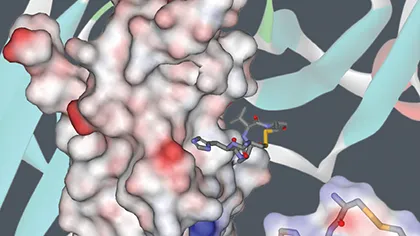Cancer drug could help those with muscular dystrophy
A team of researchers from King’s College London and University College London have discovered that the cancer drug Sunitinib...
28 January 2015
Our researchers helped develop Exherin, a new drug that aims to help stop the spread of cancer and attack established tumours which is currently being trialled in the USA.
Research led by Professor Pat Doherty, Dr Emma Williams & Dr Gareth Williams
Our researchers helped develop Exherin, a new drug that aims to help stop the spread of cancer and attack established tumours which is currently being trialled in the USA.
Exherin is a new drug that aims to help stop the spread of cancer and attack established tumours. It has been developed by Adherex Technologies in collaboration with scientists at the Wolfson Centre for Age-related Diseases and is currently being trialled in the USA.
Exherin works by stopping the activity of the protein N-cadherin. This protein supports the development of healthy cells during all stages of life and has a number of different roles within the nervous system – for example, it is involved in the growth of axons, the nerve fibres that help transmit information between neurons and to other parts of the body. But it can also help cancer cells move around the body and survive, and promote the creation of blood vessels that help tumours grow.

As cancer progresses, cells from a primary tumour can break off and travel to other places by invading nearby tissue or via the blood or lymphatic system, to form secondary tumours. Exherin may therefore help stop the movement of malignant cells and might also cut off the blood supply to tumours that have already formed.
‘N-cadherin is found on the surface of many cancer cells,’ says Professor Pat Doherty, ‘and Exherin may therefore be useful for the treatment of all sorts of different cancers. This is a promising new cancer drug.’
The research team, led by Professor Doherty and including Dr Emma Williams and Dr Gareth Williams, developed laboratory procedures to measure the activity of N-cadherin and to screen and identify compounds that could block its function.
They showed that mimetic peptides – small chains of amino acids that mimic the activity of important constituent parts of N-cadherin – could impede the action of the protein. ‘Exherin is one of the simplest of these peptides composed of only three amino acids,’ says Professor Doherty.
The team worked with researchers at McGill University in Montreal, Canada, who launched Adherex Technologies to manage the development of the new drug. Trials of Exherin, prescribed either by itself or with traditional chemotherapy, have to date shown the compound to be safe, well-tolerated and to have some benefit for patients who have melanoma or a solid tumour.
Melanoma begins in melanocytes, the cells that produce the pigment melanin that colours skin, hair and eyes. The most common form of melanoma is a cancer of the skin. Once it spreads to other parts of the body, metastatic melanoma is currently very difficult to treat.
Patients in the USA who have secondary pancreatic and biliary tract cancers are continuing to help test the safety of Exherin in a current trial sponsored by the University of Nebraska.
As a result of the work carried out by the team and their collaborators, researchers around the world are now investigating the development of drugs that affect the action of N-cadherin and other proteins from the same family, says Professor Doherty.
‘The demonstration that N-cadherin peptides can be used to block its function has opened up new opportunities for drug development,’ he says. ‘We have helped put N-cadherin peptides on the map as a new class of biopharmaceuticals to target cancer.’